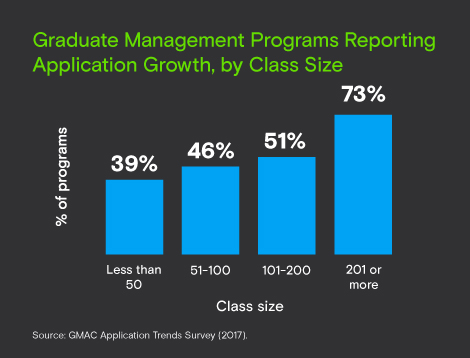Findings of the 2017 Application Trends Survey highlight shifting demand away from U.S. programs and toward Europe, Canada, and Asia

Nearly 3 in 4 (73%) graduate business programs with 201 or more class seats report increased application volumes this year compared to 39 percent of the smallest programs (50 or fewer class seats), according to GMAC’s Application Trends Survey 2017. The growth among the larger U.S. programs is driven by a resurgence of domestic applications, offsetting declines in international applicants. Regardless of class size, a majority of programs in Europe, Canada, East and Southeast Asia, and India report growing volumes in 2017, while fewer than half the programs in the United States are growing — with the exception of part-time lockstep MBA and Master in Data Analytics programs.
GMAC conducted its 18th annual Application Trends Survey from early June to mid-July 2017. The survey findings are based on a record number of responses from 351 business schools and faculties located in 40 countries representing 965 graduate management programs, including MBA, non-MBA business master's, and doctoral-level programs.

Shifting International Student Demand
Programs in Europe and Canada are about twice as likely to report growth in international applicants compared with the U.S. Across all program types, just 32 percent of U.S. programs report growing international application volumes in 2017 compared with 49 percent in 2016. Conversely, 77 percent of Canadian programs report increases in international applications (46% in 2016), as well as 67 percent of European programs (65% in 2016). Despite the Brexit vote, about two-thirds of programs in the United Kingdom (65%) have seen international demand grow.
Domestic candidates remain an area of strength for the larger, well known U.S. programs. Sixty-nine percent of programs with class sizes of more than 200 report growth in domestic applications, offsetting the fact that only 38 percent of programs similar in size report growth in international applications.
Women Make Gains
Women are increasing their representation in the graduate business school pipeline. This year women represent 42 percent of the total applications received by participating survey programs, up from 37 percent in 2013. Most program types have experienced an increase in the representation of women in the application pipeline. Specifically, among MBA programs women represent 39 percent of applications, up from 33 percent in 2013. More MBA programs report growth in female applicants (44 percent) compared with business master’s (39 percent), whereas the growth rate is similar for men — 40 percent for MBA and 39 percent for business master’s.
Split Amongst U.S. Part-Time MBA Programs
Overall volume to the general part-time MBA program category has been stagnant or on the decline since the Great Recession. Part-time lockstep programs — in which students proceed through a classroom-based program as a group — have seen stronger application volumes than part-time self-paced programs, in which students set their own schedule in a flexible format. Among U.S. part-time MBA programs, 54 percent of lockstep programs report increased volume this year, compared with just 34 percent of self-paced programs.
For more, download the GMAC Application Trends Survey Report 2017 at gmac.com/applicationtrends.